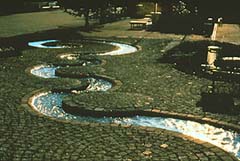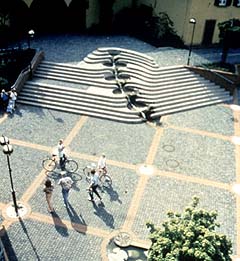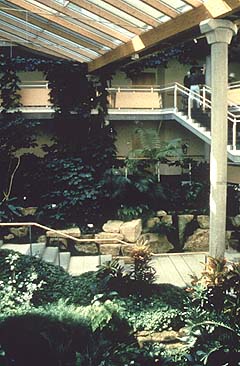
Surveys
AIA Awards
DJC.COM
November 20, 2003
Letting rainwater reign in the design process
Special to the Journal

Greif
|
Design variables — such as the site, light and views — potentially enhance the program while above-ground re-use of water persists as an unresolved factor.
Water is often treated as a hazard; collected and routed underground into a pipe for discharge off site. Controlling, concealing and removing water absorbs monetary resources that could be allocated to new innovative features, such as recycled rainwater for plumbing, heating and mechanical systems, and for irrigation and design elements in the landscape.
Without fiscal incentives to innovate beyond the code, water and architecture tend to become a relationship of avoidance.
Seemingly less typical design professionals and municipalities within the U.S. and Europe, where incentives prevail to integrate water into the design, are reshaping the social and environmental appreciation of water.
Environs at home



Photos by Jennifer Green
German designer Herbert Dreiseitl specializes in water’s role in architecture. In Beinfeld, Germany, top, he created a park with a recirculating rainwater feature; in Hatlesheim, middle, he showcased rainwater in a community staircase; and in Altesheim, bottom, he designed a rooftop system that directs rainwater into a convalescent center’s heating, air-conditioning and courtyard irrigation systems. |
According to Drew Gangnes, director of civil engineering at Magnusson Klemencic Associates, restorative storm water management systems are integrated into the site design and architecture for the Olympic Sculpture Park designed by Weiss/Manfredi Architects. By exploring inherent opportunities of the site, more sustainable systems are created via managing water runoff along its entire journey — from its point of entry to where it is ultimately discharged.
Rainwater is gathered from the inward roof folds of the park's pavilion building and focused to a central point, where it is collected at a downspout and directed to an underground cistern near the Garden of Ancients, a forest-like segment of the park. This cistern slowly releases water to a constructed marsh within this forest in a controlled manner intended to mimic nature.
The nature of existing public utility systems require that site-generated rainwater be combined with sewage and treated at the West Point Treatment Plant since no storm-drain-only pipelines exist in this area. A conventional approach would be to build large underground detention facilities that control the rate of release to these combined sewers, only to have the rainwater still treated as sewage upon its arrival at West Point.
The design for the sculpture park uses an intuitive, three-tiered approach of re-establishing storm water conveyance to Elliott Bay. First, dense tree canopies, understory plantings and ground covers hold the rainwater above the ground surface. Second, a 3-foot-thick layer of engineered soil further reduces runoff. Third, a system of pipes directs rainwater to the newly revived shoreline habitat area.
In integrating natural systems with rainwater runoff, Robert Foley & Associates developed a system that gathers water into a cistern and diverts excess runoff into a wetland for the Wing Luke Child Care Facility in Seattle. Rather than collect water, the strategy is to disperse it as close as possible to its native origin in a way that minimizes disruption to the natural system while maintaining valuable functions. Using this approach, the water sustains native habitat, restores ground water resources, and reduces erosion and flooding problems.
Steve Moddemeyer, manager for regional relations at Seattle Public Utilities, said they are carrying out a pilot program called “Raincatchers” in the Fremont neighborhood by installing 500-gallon rainwater cisterns in 24 homes to evaluate their effectiveness in dissipating storm water surges. Now finalizing the details, the agency expects homeowners can flip a valve by next summer to retain the water for irrigation.
While the direct economic savings are minimal to the homeowner, by targeting high-usage areas and peak-flow during storms, SPU hopes to control the volumes of sewage and water that need treatment. It will evaluate the finality quality of the water and runoff, test efficiency, and determine if homeowners' interest warrants expanding the program.
SPU is also experimenting with the use of “first flush devices” that monitor contaminants, typically surface pollutants, diverted to the sewer system after a rainstrom. The rainwater can then be reused for toilet flushing or irrigation. To quantify the potential savings, consider that the average household uses about 50 gallons per day on toilet-flushing in our area (low-flow toilets reduce average usage to 21 gallons per day).
In addition, rainwater collection systems at both the King Street Center and the new Seattle City Hall reuse rainwater for toilet flushing, serving as prototypes for cost-effective conservation.
Businesses that reuse and store rainwater on site are eligible for a 10 percent discount from Seattle Public Utilities.
Environs beyond
By bringing water above ground and connecting it to the environment in a way that people can see and interact with it, water lingers in its true essence, as a natural element of wonder and awe.
Herbert Dreiseitl, with Atelier Dreiseitl of Ueberlingen, Germany, has pioneered rainwater reuse systems throughout communities in his country that commemorate water in architecture, art and the environment.
In a park in Beinfeld, rainwater from adjacent buildings, roofs and plaza recirculates above ground after it is treated underground.
In Hatlesheim, rainwater is a feature of a community staircase. Rainwater emerges above ground at the top of the stairs, meandering and mingling with town life. It is stored in an underground retention tank of a community building.
In Altesheim, rainwater is gathered from the roof of a convalescent center and treated for use in the building's heating and air-conditioning system. It also is used in water features and to irrigate an interior courtyard.
Technological advances in some areas of Germany include “smart pipes” that use electrolytic sensors to monitor pollutant levels in storm drainage systems, from residential downspouts to the city utility. Retention tank sanitizers use ultraviolet lights to purify water stored in the system.
Sven Schunemann of Flowforms America, based in East Troy, Wis., is developing an incentive program for homeowners to install retention and/or rain water dissipation systems. Envisioning five options for homeowners to select a system for usable rainwater, a city reaps the benefit of managing reduced volumes of rainwater. The dynamic potential of incremental changes across neighborhoods reduces the expense of treating millions of gallons of water, creating an economic windfall and benefiting residents and municipalities.
Shared enterprise
An individual's use of water potentially affects what's in your neighborhood stream and the access of the vendor down-the-street to water. Some exemptions to water rights appear to be viable, envisioned in parallel with the concept of private wells. The complexities associated with water rights proliferate with each legislative session but undoubtedly impact options for dealing with rainwater.
Ensuring adequate and clean water for people, along with their business enterprises, and all living species continues to call for inventive and interdisciplinary approaches to design and engineering. While LEED and the Uniform Plumbing Code foster conservation, more creative incentives — fiscally, socially and environmentally — hold the power to sway homeowners and stakeholders for future development.
Joseph Greif, AIA, is principal of Joseph Greif Architects. Dyan Pfitzenmeier is a writer and consultant.
Other Stories:
- Today's buildings load up on technology
- Monorail to move urban design as well as people
- Church praises the benefits of adaptive re-use
- UW builds on design leadership training
- Science studies how architecture affects the brain
- China creates a park with environmental appeal
- How the Great Fire changed Seattle's architecture
- Architects play catch-up in the business world
- Designing with nature in the balance
- 12 keys to creating authentic people places
- Water tower repairs borrow on building technology
- Technology takes center stage in performance halls
- In hospitals, spending more can save money
- Don't be violated — protect plans with copyrights
- Special dampers may shake up engineering field
- UW Allen Center fosters a culture of research
- Here's why projects need to be commissioned
- Unwrapping modern building envelopes
- Lessons on sustainability, Scandinavian style
- Building a highrise on the fault line
- How to keep development from killing trees
- Rx for changing healthcare industry: Good design
- Muckleshoot project blends culture with design
Copyright ©2009 Seattle Daily Journal and DJC.COM.
Comments? Questions? Contact us.